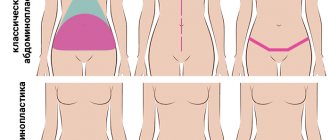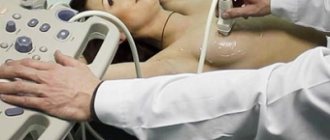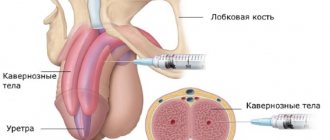Causes of occurrence Indications Contraindications How is the operation performed? Rehabilitation Questions and Answers
Diastasis is a condition in which the distance between the rectus abdominis muscles increases. As a result, the stomach becomes round and looks unaesthetic. This defect can occur in women after childbirth, men and even children. The danger of diastasis is that it not only spoils the figure, but also increases the susceptibility to hernias and can lead to muscle atrophy and prolapse of internal organs.
There are three stages of this disease based on the width of the muscle divergence:
- from 5 to 7 cm;
- 7 cm;
- over 10 cm.
There may be no symptoms, but most often a sagging stomach, pain, heaviness, discomfort even at rest, constipation, and belching immediately appear.
Exercises to tighten the abs with such a disease have the opposite effect, the situation only gets worse, and the stomach increases in size. This happens because the “white line” of the abdomen consists of connective tissue, which is why it cannot contract. Diastasis of the rectus abdominis muscles can be removed by suturing the gap formed between them.
Causes of the disease
Among women
The main reason for women is pregnancy. The increasing size of the uterus puts pressure on the “white line”, stretching the connective tissue, which gradually becomes thinner. The number of pregnancies, the density of connective tissue and its ability to stretch play an important role. With age, the strength of the “white line” decreases, therefore, the older the age at which pregnancy occurs, the higher the risk.
In children
In newborns, this is considered normal because the muscles are not yet strong enough. Even a full stomach can easily move the rectus muscles apart. Gradually, tissues and muscles become stronger, and the pathology goes away. This process is delayed in premature and weakened children. With Down syndrome, diastasis can remain for life.
In men
The main reasons are high body weight and heavy lifting. It is important to strengthen the abdomen in childhood, otherwise after 30 years, as tissue elasticity is lost, diastasis may develop.
Exercises to strengthen the abdominal muscles
Inclusion of oblique abdominal muscles, lateral bends, various variations of plank pose and specially adapted training for our students, taking into account increasing load from minimal to intense.
You can choose any 3-5 exercises and start with 10 repetitions on each side.
Side plank scissors, knee on the floor
Oblique abdominal muscles, back muscles, lateral thigh muscles, arm muscles.
Starting position (IP): lie on your side, support on your elbow, elbow strictly under your shoulder, supporting leg bent at the knee, back straight.
We lift the pelvis off the floor, the body is tense, from the shoulder to the knee - one straight line. Raise the straight left leg up, then lower it to the floor and lower the pelvis into the IP.
Side plank scissors
Oblique abdominal muscles, back muscles, lateral thigh muscles, arm muscles.
IP: lie on your side, support on your elbow, elbow strictly under your shoulder, legs straight, back straight.
As you exhale, lift your pelvis off the floor and lift your upper leg as high as possible. With an inhalation, we lower it and return to the starting position. IMPORTANT: do not lean to the side, the body is as tense as possible.
Side fold
Oblique abdominal muscles.
IP: lying on your side, the lower arm lies along the body, the other hand behind the head (elbow looking to the side). Legs are straightened, in the air, parallel to the floor (but do not lie on it!).
On the count of “one”, with an exhalation, we perform twisting to the side, trying not to just bend our legs at the knees, but to raise them as high as possible, reaching with our elbows towards our knees. The supporting arm bends at the elbow during twisting. On the count of “two” we return to IP. IMPORTANT: keep your feet on the floor throughout the entire exercise. We don’t lean forward or backward.
Dynamic side plank with forearm (knee on floor)
Oblique abdominal muscles.
IP: side plank from the forearm, the elbow is clearly under the shoulder, the supporting leg is bent at the knee 90 degrees and lies on the floor, the back is straight, the pelvis is twisted, the body is one straight line.
Slowly raise and lower your pelvis, tensing your abdominal muscles. IMPORTANT: the back is always straight, raise the pelvis as high as possible, try not to touch the floor at the lowest point, stop the pelvis 1-2 cm from the floor.
How is surgery performed for muscle diastasis?
First, the patient consults with a surgeon, the doctor examines the abdomen and determines the amount of work and method of operation. After this, the patient undergoes a standard examination - tests:
- general urine analysis;
- clinical and biochemical blood tests;
- coagulogram (blood clotting test);
- blood tests for syphilis, HIV, hepatitis B and C.
It is necessary to do an ECG and fluorography; in addition, an ultrasound of the abdominal organs may be prescribed.
With the results of examinations and tests, you need to go to a therapist. He analyzes the results and, if there are no contraindications, signs a referral for surgery. The patient then consults with an anesthesiologist.
Two weeks before suturing, you need to eliminate alcohol from your diet, stop smoking, or reduce the number of cigarettes by half. Only a light dinner is allowed the night before.
Before the operation, the surgeon takes a photo of the patient’s abdomen in order to visually evaluate the result.
There are two methods of performing the operation - tension and non-tension.
The operation lasts up to two hours and is performed under general anesthesia.
Tension technique
The rectus abdominis muscles are tightened and fixed in their normal position. The stomach becomes flat, and the subcutaneous tissue strengthens.
Tension-free technology
An implant is installed in the area of the defect. The suturing operation in this case can be performed laparoscopically (through punctures using an endoscopic instrument) or open access (an incision is made on the anterior abdominal wall along the navel fold or along the diastasis line).
After suturing the diastasis, stitches are applied and a dressing is done. If tension abdominoplasty was performed, the patient is given a bandage to stabilize the result.
Contraindications to taping
A rash on the abdomen is a contraindication to taping
You can use the method only if there are no contraindications, which include:
- skin diseases: open wounds, rashes, contact dermatitis and sensitivity to the materials that make up the tapes;
- oncological diseases in the metastatic stage;
- increased temperature and swelling after a viral or infectious disease;
- vascular thrombosis in any area of the body;
- unidentified diseases and symptoms, the causes of which are not clear;
- diabetes mellitus and other hormonal disorders.
In the latter case, tapes can be used only after consultation with an endocrinologist.
In some cases, the use of strips is justified even if there are minor lesions on the skin. Then an antiseptic bandage is applied on top. But in this situation, the taping procedure should be carried out by a medical professional.
Ignoring contraindications can lead to worsening of diastasis recti and changes in the patient’s general well-being.
Rehabilitation
The rehabilitation period is relatively easy. At first there is swelling, hematomas, and pain. The first ones gradually go away on their own, and the pain is relieved with a drug prescribed by the doctor.
In the first month, you should not lift anything heavier than 3 kg. For two months you should not overheat, go to the sauna, sauna, or take a hot bath. The body must be protected from the sun; you cannot sunbathe or swim in the pool. Sports are also banned for two months.
The bandage is worn for 2-3 months.
Kinesio taping of the abdomen after childbirth
In all women, after 9 months of pregnancy, the muscles become overstretched, so after childbirth, experts recommend wearing a bandage to speed up the recovery process. Depending on the physical condition of the woman, her weight, hereditary factors, the abdomen may not fully recover - sagging and sagging tissue will remain.
But recently, young mothers are increasingly resorting to taping. After all, this method has several advantages compared to a bandage:
- The load on the muscles is not completely removed, but the pain syndrome goes away.
- It is enough to stick the tapes once, wear them for 5 days and do exercises if possible. This time saving is especially important when the child is small. In addition, you can wear any clothes and take a shower with tapes.
- Elastic patches improve microcirculation in the area of application, so skin turgor improves and tissues are restored.
In this case, you need to apply tapes while lying on your back - this will require 2 strips of the same length. They are glued across the entire width of the stretched muscles, while the tension of the patch in the middle part should be 50%, and the edges are fixed without stretching.
At the same time, you can do taping of the oblique muscles. To do this, the patient sits down, and the first anchor is glued next to the spine without tension. Next, the tape is stretched by 30-50% and guided downwards in the direction of the costal arch, while it should cross the damaged muscle, but not reach the midline. In case of severe damage, it is recommended to apply several tapes at once.
Deep breathing
Another exercise recommended for abdominal diastasis is diaphragmatic breathing. It is recommended to anyone who is faced with the problem of muscle relaxation, but most of all it is useful for women who have already carried one child, have learned for themselves what diastasis is, and are planning to conceive a second baby. Diaphragmatic breathing can reduce the likelihood of muscle separation during a new pregnancy. It is impossible to overestimate such activities, because due to diastasis, the supporting function of the body is weakened, and this harms both the back and all internal organs. If the uterus does not have sufficient support, the risk of a complicated birth increases. Correctly performed deep breathing can reduce such dangers and tone the muscular skeleton of the peritoneum. At the same time, the rhythm of heart contractions improves, blood pressure decreases, and stress goes away.
A fairly simple breathing exercise for diastasis of the abdominal muscles is done in a sitting or horizontal position. In the first case, you need to choose a flat, flat surface to sit on, on which you can cross your legs. If you decide to lie down, then first spread gymnastic foam. The woman’s task is to draw in the air as deeply as possible so that there is a feeling of maximum filling of the peritoneum and sternum. Then the air is released slowly, gradually, with tension in the abdominal press. It is recommended to repeat this a dozen times. At least three such approaches should be done per day.
What to do?
In order to solve this problem during the postpartum period, it is necessary to develop special practices designed to combat diastasis. Exercises that are useful for a particular case will be determined by the attending physician. You cannot practice the exercises on your own without first contacting your doctor. In a number of conditions, exercise is strictly prohibited. Women who have undergone a caesarean section must be especially careful.
Diastasis can be suspected already during pregnancy. If this is the case, you should consult a doctor. A physiotherapist will assess the condition of the muscles and advise you on how to adjust your daily routine before childbirth so that the risks and negative consequences are minimal.
If the condition is very severe, none of the abdominal exercises generally recommended for diastasis will help a woman and, moreover, are contraindicated. The doctor, having examined the condition of the tissues, may recommend urgent surgery.
Pelvic tilts
There are many practices that, as others claim, help with abdominal diastasis after childbirth. The exercises are known both those that have been tested over the years and those that are considered new. When choosing your option, you need to critically evaluate the promises of the program. There are cases where widely advertised programs promised women absolute healing in just a few weeks, but in fact only made the person worse. There are even cases when official medical commissions and associations published printed materials devoted to refuting the statements of the authors of such programs. However, this has nothing to do with pelvic tilts. Such exercises are one of the main ones in Pilates and yoga. The practice is aimed at strengthening the transverse muscles. The practitioner’s task is to concentrate on the pelvic muscles in order to activate the gluteal areas.
The exercise recommended for abdominal diastasis, which shows good results after childbirth, starts from a horizontal position. You must lie on your back. The limbs are bent at the knees, palms pointing down. The upper limbs are placed on the lower block of the abdomen, straining the muscle tissue here. They monitor their breathing so that it is even and calm. The pelvis is tilted upward until the lower back lies on the plane of the floor. The shoulders are relaxed throughout the session. The duration of maintaining the top position is 10 seconds. Next, the pelvis is relaxed. One approach - five repetitions.
Partial twist
This exercise for diastasis after childbirth begins with taking the starting position: a horizontal position on your back on a special gymnastics mat. The head is raised, the upper area of the back is torn off the surface, slightly rounded. Keep the upper limbs straight and stretch them towards the knees, straining the abdominal muscles. No special dynamic movements are needed. Maintain the maximum tense position for 10 seconds, after which you relax the muscles and give yourself a short rest. It is recommended to do five consecutive approaches. The minimum duration of the exercise course is a couple of weeks. You simply won’t be able to see any improvement in your condition in a shorter period of time.











